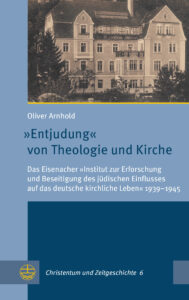Contemporary Church History Quarterly
Volume 30, Number 3 (Fall 2024)
Review of Oliver Arnhold, “Entjudung” von Theologie und Kirche: Das Eisenacher “Institut zur Erforschung und Beseitigung des jüdischen Einflusses auf das deutsche kirchliche Leben” 1939–1945 (Leipzig: Evangelische Verlagsanstalt, 2020). ISBN: 9783374066223; 245 Pp.
Dirk Schuster, University of Vienna
If you have a look at church history during the Third Reich, you will quickly come across the “Institute for the Study and Elimination of Jewish Influence on German Church Life” (Institut zur Erforschung und Beseitigung des jüdischen Einflusses auf das deutsche kirchliche Leben). Susannah Heschel began to work on the history of this “De-Judaization Institute” with her first contributions in the 1990s. In 2008, she published The Aryan Jesus, the first monograph to focus on the “Eisenach Institute” and its key protagonists.[1] Just two years later, Oliver Arnhold published his doctoral thesis on the “De-Judaization Institute”, which, in two volumes of over 900 pages, provides a detailed description of its origins, structure, publications and staff.[2]
 Ten years later, Arnhold has published a condensed version of his doctoral thesis. In 245 pages, he tells the history of the establishment of the largest research institute in the Third Reich that dealt with the so-called “Jewish question”. Promoted by the Thuringian German Christian Church Movement (Kirchenbewegung Deutsche Christen), the institute was opened at Wartburg Castle in Eisenach – one of the most important places for Protestants –in May 1939 with the intention of tracing and eliminating all Jewish influences within (Protestant) Christianity. The aim was to prove – on its own initiative, without state influence, supported by various Protestant regional churches and with the collaboration of renowned professors – that Jesus of Nazareth, and with him Christianity as a whole, had always stood in extreme contrast to Judaism. Jews, however, had distorted the true message of Jesus, which the Eisenach Institute was to bring to light again. Accordingly, some of the staff also saw themselves as completing Luther’s Reformation. Luther had liberated Christianity from the papacy in the sixteenth century. Now, under the rule of the “God-sent Führer” Adolf Hitler, the time had come to accomplish in full Luther’s Reformation and remove all alleged Jewish influences from Christianity. The message of Jesus and, indeed, his entire person were to be “de-Judaized” (entjudet) – nothing more and nothing less.
Ten years later, Arnhold has published a condensed version of his doctoral thesis. In 245 pages, he tells the history of the establishment of the largest research institute in the Third Reich that dealt with the so-called “Jewish question”. Promoted by the Thuringian German Christian Church Movement (Kirchenbewegung Deutsche Christen), the institute was opened at Wartburg Castle in Eisenach – one of the most important places for Protestants –in May 1939 with the intention of tracing and eliminating all Jewish influences within (Protestant) Christianity. The aim was to prove – on its own initiative, without state influence, supported by various Protestant regional churches and with the collaboration of renowned professors – that Jesus of Nazareth, and with him Christianity as a whole, had always stood in extreme contrast to Judaism. Jews, however, had distorted the true message of Jesus, which the Eisenach Institute was to bring to light again. Accordingly, some of the staff also saw themselves as completing Luther’s Reformation. Luther had liberated Christianity from the papacy in the sixteenth century. Now, under the rule of the “God-sent Führer” Adolf Hitler, the time had come to accomplish in full Luther’s Reformation and remove all alleged Jewish influences from Christianity. The message of Jesus and, indeed, his entire person were to be “de-Judaized” (entjudet) – nothing more and nothing less.
In the first part of the book, Arnhold devotes himself to the institute’s prehistory, i.e. how the Eisenach Institute came to be founded in the first place. The German Christians are discussed, and Arnhold devotes a separate chapter to Walter Grundmann, the scientific director and spiritus rector of the institute, as well as the infamous Godesberg Declaration. At this meeting in March 1939, attended by leading church representatives from most German Protestant regional churches, Christianity was defined as the greatest possible opposition to Judaism and the founding of the “De-Judaization Institute” was decided.
In the second part of the book, Arnhold focuses on the opening of the institute at Wartburg Castle in Eisenach, the place where Martin Luther had translated the Bible into German. Individual chapters are devoted to the structure, thematic research topics inside the working groups like the origin of Jesus and German piety, the “de-Judaization” of the New Testament and the Protestant hymnal, the relationship with the state and the Nazi Party, and the dissolution of the institute in 1945. The respective careers of institute employees after 1945, which Arnhold describes on eleven pages, are always shocking. There were very few postwar professional restrictions for former employees, despite their antisemitic writings up until 1945.
Anyone familiar with the subject of the Eisenach Institute will not find anything new in this book. However, this is not the author’s intention so much as he wishes to present a compact overview of the German Christian Church Movement and the Institute for the Study and Elimination of Jewish Influence on German Church Life. He has succeeded well in summarizing his doctoral thesis on which this book is based. For those readers who are not yet familiar with the history of the Eisenach Institute, the book offers a quick and easy-to-understand insight into the subject.
Notes:
[1] Susannah Heschel, The Aryan Jesus: Christian Theologians and the Bible in Nazi Germany (New Jersey: Princeton University Press, 2008).
[2] Oliver Arnhold, Kirche im Abgrund. Vol. 1: Die Thüringer Kirchenbewegung Deutsche Christen 1928–1939; Vol. 2: Das »Institut zur Erforschung und Beseitigung des jüdischen Einflusses auf das deutsche kirchliche Leben« 1939–1945 (Berlin: Institut Kirche und Judentum, 2010).
